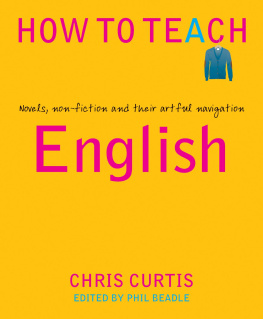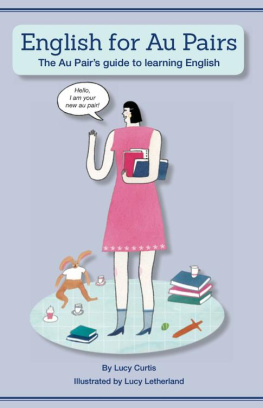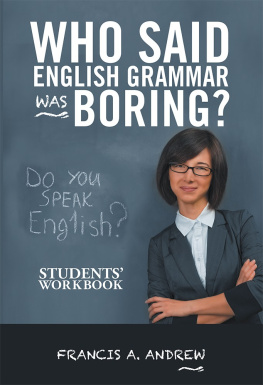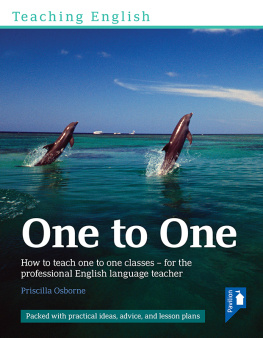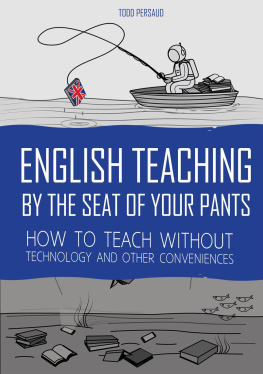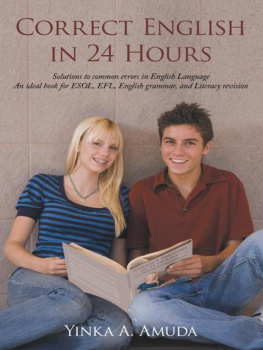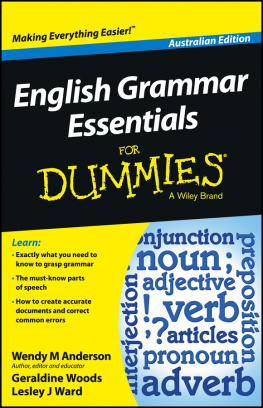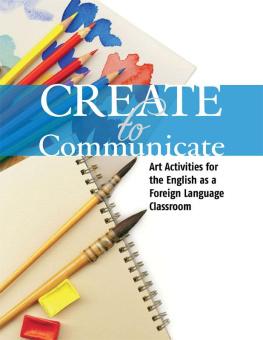PRAISE FOR
HOW TO TEACH: ENGLISH
Chris Curtis is the ideal teacher-writer, and in How to Teach: English he effortlessly manages the artful balance of packing in sage insights alongside a range of very practical approaches.
Funny, wise and imminently useful, this is a book from which every teacher of English from nervous newbies to seasoned veterans can plunder a wealth of ideas. So, no matter if you are perennially busy: put down your pile of marking and gift yourself this readable gem.
Alex Quigley, Senior Associate, Education Endowment Foundation and author of Closing the Vocabulary Gap
Chris book is an excellent manual for new and experienced teachers alike. His mixture of wisdom and experience blends together to provide teachers of English with a number of ideas that they can use in the classroom. It is a timely text, one which encourages practitioners to love what they teach and is ideal for dipping in and out of, allowing readers to turn their attention to the chapters which cover their teaching focus at the time of reading. It is also packed full of signposts to interesting works of literature, which are perfect for the busy English teacher looking for some inspiration with the texts and topics theyre using in a lesson or during a unit of learning.
Amy Forrester, English teacher and Head of Year, Cockermouth School
Curtis smart and shrewd guide to English teaching is a welcome reminder of the potent, and too often untapped, wisdom and expertise of those at the chalkface who have learned through many years of careful and thoughtful trial and error.
For me, the greatest strength of this book lies in its central message: that English teaching is about the communication, sharing and generation of ideas, and that what matters most is the quality of thinking that happens within an English classroom. To top it off, Curtis gifts us a dazzling array of simple approaches that will guide all English teachers from the fresh-faced newcomer to the grizzled staffroom-cynic towards nurturing and getting the very best out of their students.
How to Teach: English really is a fabulous read. I cannot remember the last time I took so many notes when reading an education book. Needless to say, I recommend it to all teachers of English.
Andy Tharby, author of Making Every English Lesson Count
How to Teach: English is packed full of practical ideas for the English classroom. Chris knowledge and experience shine through in his writing, as he shares what he demonstrably knows will work in practice and provides really sound advice for trickier areas of the curriculum.
This is a timely book schools wanting a renewed focus on the application of the curriculum would do well to start here for their English faculties.
Sarah Barker, English teacher and Assistant Head Teacher, Orchard School Bristol, and blogger
Why, you might wonder, should I invest in yet another book on the teaching of English? This is a relatively crowded marketplace and although there are many excellent books aimed at English teachers, none are so rooted in the subject as this one. Chris Curtis communicates not only his years of experience but also his infectious enthusiasm for a subject and an occupation he so clearly loves.
How to Teach: English is studded with an astonishing array of practical ways into the study, and the teaching, of all forms of literature as well as the nuts and bolts of language. Every page is illuminated by the gentle, guiding hand of someone who has been there, made all the mistakes you have made and survived to pass on the distilled wisdom and warmth of a true aficionado.
This is my new favourite book on English teaching it will enhance the practice of any teacher of English, no matter what stage they are at in their career.
David Didau, author of Making Kids Cleverer
How to Teach: English is clever, wise and highly practical. Awash with creative prompts and pragmatic advice, it is an accessible and entertaining read which deserves its place on the creaking bookshelves of any English teacher.
Dipping in, youll find the kinds of ideas that make you think, I wish Id thought of that. At the same time, Chris obsession with self-improvement shines through. Full of humility, honesty and mischievous humour, this is a book about getting better by to paraphrase the title of Chris hugely influential blog learning from mistakes.
It includes an ambitious and comprehensive list of chapters focusing on key areas such as writing, grammar, Shakespeare and poetry and illustrates the necessity of building knowledge and questioning our assumptions about our students prior learning. With his approach, Chris places a relentless focus on the writers craft and the power of words, advocating a sensible balance of high challenge, accessibility and creativity.
Quite simply, How to Teach: English is a guide to what excellent English teaching looks like so whether youre a trainee teacher or a battle-hardened veteran, this is an indispensable resource.
Mark Roberts, English teacher, blogger and writer
This is a magnificent book that really gets to the bones of teaching English. It manages the remarkable feat of scoping the panorama of the subject: its magic, its power and its potential to take students to other worlds. And set against the big picture are commentaries on, and brilliant examples of, how to bring English lessons to life in the classroom.
How to Teach: English should be essential reading for all engaged in teaching, not just of English but of other subjects too everyone will take something from the precision, the wit and the humanity of this terrific book.
Mary Myatt, author of Hopeful Schools, High Challenge, Low Threat and The Curriculum: Gallimaufry to Coherence
Id like to thank the following people for helping me on my journey:
The English teachers I have worked with and alongside: Sam, Oisin, Chloe, Laura, Ann F., Nicki, Jas, Ian, Fiona, Sharon, Rhonda, Sally, Sue, Janice, Linda, Lorna, Sheridan, Steve, Anne B., Jenny, Delphine, Cliff, Gideon, Pat and Gill.
The English teachers who taught me: Mrs Keeling, Mr Powell, Mr Bic and Mr Ross.
The teachers on Twitter who have supported me or who have helped my thinking over the years.
Fiona Folan and David Bunker for their support and help.
Im grateful for the generosity of my fellow professionals in sharing their experience and ideas, which has inevitably influenced my practice and, thus, the strategies I share here. I have tried to acknowledge the source of all contributions to my thinking, but if I have overlooked anything, or anyone, please trust that this is in genuine error.
A special thanks to Phil Beadle for offering me this great opportunity.
And, last of all, Id like to thank my wife, Chloe, and my daughters, Niamh and Mya, for putting up with me.
English teaching can sometimes, and sadly, be the province of the unthinking trope: the thing the majority does that is both quite silly and very rubbish. Particular bugbears of mine are students being taught stock phrases that stack up like meaningless tautologies, making exam answers comprehensibly silly. Writing This clearly shows about poetry (it clearly doesnt) and scribing parades of de-contextualised conjunctive adverbs as discourse markers (furthermore nothing, moreover less) being only the ones that have got my goat this week.
It is a shame that an honourable profession filled with teachings finest accepts this waffle as being in any way deserving of anything other than lots of red pen. And such practices lead one into the direction of a search for an answer. What does anything mean? Who am I to trust here? Where is the voice of seasoned reason?

